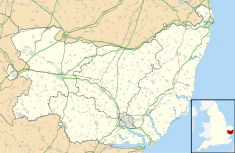
Eye is a market town and civil parish in the Mid Suffolk district, in the north of the English county of Suffolk, about 4 miles (6 km) south of Diss, 17.5 miles (28 km) north of Ipswich and 23 miles (37 km) south-west of Norwich. The population in the 2011 census of 2,154 was estimated to be 2,361 in 2019 and updated to 2,210 following the 2021 census. It lies close to the River Waveney, which forms the border with Norfolk, and on the River Dove. Eye is twinned with the town of Pouzauges in the Vendée department of France.

Suffolk County Council is the upper-tier local authority for the county of Suffolk, England. It is run by 75 elected county councillors representing 63 divisions. It is a member of the East of England Local Government Association.
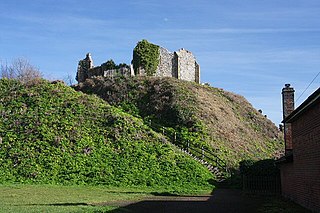
Eye Castle is a motte and bailey medieval castle with a prominent Victorian addition in the town of Eye, Suffolk. Built shortly after the Norman conquest of England in 1066, the castle was sacked and largely destroyed in 1265. Sir Edward Kerrison built a stone house on the motte in 1844: the house later decayed into ruin, becoming known as Kerrison's Folly in subsequent years.

Runcorn Town Hall is in Heath Road, Runcorn, Cheshire, England. It is recorded in the National Heritage List for England as a designated Grade II listed building. It was originally built as Halton Grange, a mansion for Thomas Johnson, a local industrialist. After passing through the ownership of two other industrialists, it was purchased in the 1930s by Runcorn Urban District Council and converted into their offices. Since 1974, it has been the meeting place for Halton Borough Council.

Ealing Town Hall is a municipal building in New Broadway, Ealing, London, England. It is a Grade II listed building.

Torquay Town Hall is a municipal building in Castle Circus in Torquay, Devon, England. The building, which is the meeting place of Torbay Council, is a Grade II listed building.

Lowestoft Town Hall is a municipal building in the High Street, Lowestoft, Suffolk, England. The town hall, which was the meeting place of Lowestoft Council, is a Grade II listed building.

Congleton Town Hall is a municipal building in the High Street, Congleton, Cheshire, England. The town hall, which is the meeting place of Congleton Town Council, is a grade II* listed building.
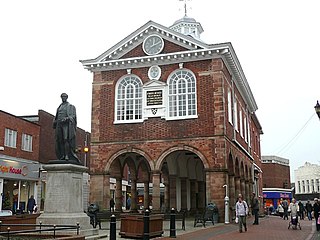
Tamworth Town Hall is a municipal building in Market Street, Tamworth, Staffordshire, England. The town hall, which is the meeting place of Tamworth Borough Council is a Grade II* listed building.

Trowbridge Town Hall is a municipal building in Market Street, Trowbridge, Wiltshire, England. The town hall, which was the headquarters of Trowbridge Urban District Council, is a Grade II listed building.

Evesham Town Hall is a municipal structure in the Market Place in Evesham, Worcestershire, England. The town hall, which was the headquarters of Evesham Borough Council, is a Grade II listed building.

Farnham Town Hall is a municipal building in South Street, Farnham, Surrey, England. It provides the offices and the meeting place of Farnham Town Council.
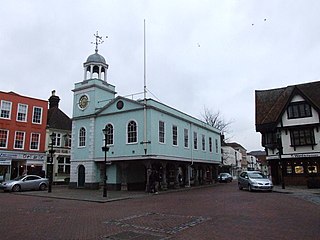
Faversham Guildhall is a municipal building in the Market Place in Faversham, Kent, England. The structure, which was the meeting place of Faversham Borough Council, is a Grade II* listed building.

Chipping Campden Town Hall is a municipal building in the High Street, Chipping Campden, Gloucestershire, England. The building, which is the meeting place of Chipping Campden Town Council, is a Grade II* listed building.

Wayland Hall, also known as Watton Town Hall, is a community events venue in Middle Street, Watton, Norfolk, England: the structure, which also accommodates a local history museum, is a grade II listed building.

The Moot Hall is a municipal building in Market Cross Place in Aldeburgh, Suffolk, England. The building, which is the meeting place of Aldeburgh Town Council, is a Grade I listed building.

Hadleigh Town Hall, also referred to as the New Town Hall, is a municipal building in the Market Place in Hadleigh, Suffolk, England. The building, which is the meeting place of Hadleigh Town Council, is a Grade II listed building.
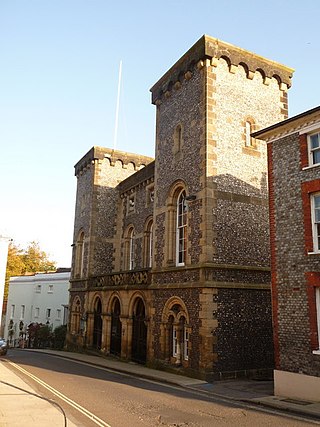
Arundel Town Hall is a municipal building in Maltravers Street in Arundel, West Sussex, England. The building, which is the meeting place of Arundel Town Council, is a Grade II listed building.

Malmesbury Town Hall is a municipal building in Cross Hayes in Malmesbury, Wiltshire, England. The structure, which is the meeting place of Malmesbury Town Council and the home of the Athelstan Museum, is a Grade II listed building.

Dumbarton Municipal Buildings is a structure in Glasgow Road, Dumbarton, West Dunbartonshire, Scotland. The structure, which is used as a venue for weddings and civil partnership ceremonies, is a Category B listed building.

